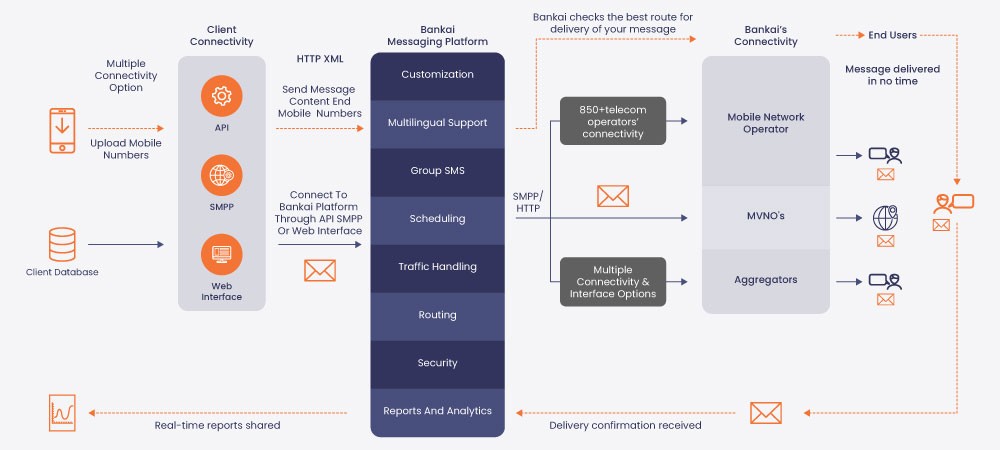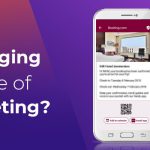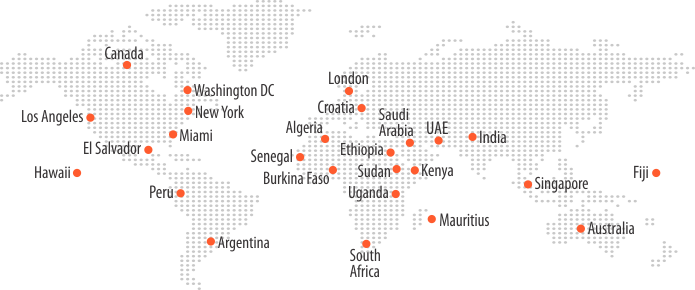A2P Messaging: The “Future forward” Catalyst or an Unsubstantiated Guess?

Friedhelm Hillebrand and Bernard Ghillebaert developed the concept of SMS in 1984 but the first text message “Merry Christmas” was sent in 1992 by Neil Papworth to Richard Jarvis from a PC, due to mobile phones not having a keyboard. Nokia was the first handset manufacturer to have a phone line that supported SMS text sending in 1993. It later became the first manufacturer to build a mobile phone with a full keyboard in 1997. From 0.4 text messages per month per American user in 1995 to the premium A2P and P2P Messaging Market valued at USD 65.61 billion in 2019, the world has witnessed business entities increasing their focus and spending on consumer interaction vis A2P SMS service; across domains- FMCG, Banking, Hospitality, Healthcare. For the period 2020-2027, growing at a CAGR of 5.62%, it is projected to reach USD 98.51 billion by 2027- And guess how? By businesses just looking into their own database of numbers that’s already accessible and ready to use.
At the Helm of a New Dawn
Technology may have made our lives easier but in many parts of the world, technology is still optional especially the evolved, high-tech, high-maintenance kind. While the pandemic did slow us down, as customers we never stopped asking for better services. As consumers, we still held the power to threaten equilibrium by moving from service to service in search of someone who treated us well, stayed connected, and made our needs their priority. Services that made us feel well taken care of. Another aspect that came to haunt us is the need to do things on our own amidst the chaos of the physical distancing and numerous the pandemic rules and regulations. Staying safe became the goal but work had to happen, bills had to be printed, acknowledgments to be sent, appointments to be made, connections to be built, existing relations to be invested in loyalties to be celebrated, all within the boundaries of pandemic regulations.
Is Enterprise Messaging a Guesswork Awaiting Failure?
At the starting of the chaos created by the Pandemic, there was a commotion that the services will collapse, years of work on building loyalties be lost while A2P messaging was painted as a complex and insecure service option. But in the hindsight, the lack of action and proactive A2P utilization as a service would have definitely killed customer relations. Every service has its challenges, and every strategy comes with a risk. Those who capitalized on the opportunity would tell you that staying committed to enterprise messaging was a calculated risk, but not guesswork. Numbers back up A2P messaging credibility.
In May 2021 it was reported that the top 5 highest number of smartphone users belong to the following countries: China (911.92 million), India (439.42 million), the United States (270 million), Indonesia (160.23 million), Brazil (109,36 million). (Statista). While new technologies created new opportunities to fill in the gaps of existing technology embedded in the weave of society, SMS services needed no fancy phones, no Internet, no real technical knowledge – to stay connected, be valued, and to be acknowledged. And this was not meant for just the cream of the layer, this old-age technology was ready to take over the world’s densest as well as approachable set of people in the most bias-less environment.
During the Pandemic, all the technical advances, internet-dependent services required maintenance but, in the chaos, SMS survived and thrived without the Internet and expensive multimedia devices. In the past two years, SMS services have found their way back into the headlines. The A2P SMS messaging service has been offering a wide range of products, and opportunities covering everything under the sun- be it customer care, billing, community building, employee engagement, Government notices, reminders for services, marketing, and many more.
On a global scale, the total number of cellphone users in 2016 was 3668 billion which is expected to reach 7516 billion by 2026. (Statista). Approximately 1.8 billion millennials (23% of the global population) have a smartphone (MSCI) and 76% of them prefer texting. (TextMagic, 2019). If this doesn’t look like numbers that can aid a strategic business opportunity but guesswork then we will never know what actual failure is, because A2P messaging at the least doesn’t seem to lose its “disruptive aided service” status anytime soon.
How does it work? / A2P Process Flow
Types of Premium A2P and P2P Messaging Market
By Platform
- Traditional and Managed Messaging Platform
- Cloud API Messaging Platform
By Traffic
- National
- Multinational
By Application
- Interactive Messages
- Inquiry and Search Related Services
- Voting and Entertainment
- Authentication Services
- Notifications and Alerts
- CRM Services
- Promotional and Marketing Services
- Pushed Content Services
By Vertical
- Telecom
- Government
- BFSI
- Transport and Logistics
- Retail and e-commerce
- Software and IT
- Energy and Utilities
- Media and Entertainment
- Healthcare
A2P Messages Core Offerings:
Security & Fraud Prevention:
There are different ways including one-time passwords (OTPs), passwords with timers, or a two-factor authentication (2FA) solution for fraud prevention.
- Mobile eKYC Authentication
- OTPs and timebound passwords
- Increased Customer Security-Enhanced Data Security by Encrypted Data Storage
- Efficient Detection of Illegal Routes and Blocking of Grey Routes
- Spam Avoidance
Critical Communication:
In cases of natural disaster, or during an emergency response scenario, SMS has the reach and delivery window needed for criticality.
- Alerts and Reminders
- A2P Monetization
- Enabling omnichannel experiences
- Possible communication for Useful Links with Integrated Shortlink Support
Customer care and Relationship Management:
SMS has a robust and reliable network for the detail-oriented work for Customer care services. Appointments, acknowledgments, service-related information, paperless bills, etc. can be taken care of while nurturing the existing or newly built client-service provider relationship.
- 24*7 Client Support and Reliable Solution
- Multi-language Support for Global appeal and reach
- Improved Customer Retention
- Reduce Wait Time and Smooth Checkouts
- Better Stock Management and Optimized Delivery
- User Registration and Set Preference
- Review and Feedback Collection
- Experience-driven Campaigns, Rich Media Capabilities, and Promotion capabilities
- Traffic from Multiple Entry Points and Traffic Comparison
- Email Automation
- Real-time information for better Analytics and Actionable Insights
Sustainable and Actionable Delineators of A2P Messaging:
- Simple and immediate: Offers an easier reach and immediate delivery.
- Cost-effective: A2P is one of the most inexpensive methods of marketing and communication but has the same reach as traditional marketing.
- High response rate: SMS has eight times the response rate and 97% open rate make of an email.
- Personalization: Customized SMS based on customers’ preferred interests and choices helps create an experience that is personal and relatable.
- Integration with other channels: The use of different platforms to drive traffic works because of A2P’s seamless integration capabilities.
- Opt-in and Opt-out: The freedom to unsubscribe makes the customer stay for a longer period.
- Support two-way interactions: Two-way SMS services are deemed to be meaningful and genuine.
- Data service redundancy: Being independent of the internet for sending SMS creates a seamless connection that can stay connected for a longer duration of time.
- High penetration in remote locations: Text messages can reach remote locations especially ones without internet and smartphones.
- Analytics: Data collection and analysis of SMS campaigns through metadata is possible.
Factors Affecting Optimized Messaging Services:
Variety of Rules and Regulations and Restrictions:
Rules, regulations, and restrictions control different geographies, and many times the difference is created between rival service providers. This is the result of incorporating own business processes, self-regulation that controls all the aspects of A2P services -from content restrictions, word limit to ownership.
Some of the more prominent regulations are:
- Registered sender names– In some countries, A2P messaging is only allowed for registered users with the network operators.
- Sender ID restrictions– Many mobile network operators require Sender IDs.
- Short coders – Some countries allow only shortcode senders- licensed directly by the operators.
- Sender signature included in the text – In some countries, the sender’s signature in the message body makes it a valid message.
- Appropriation – Messaging content is investigated to read between the lines and stop any scams from happening. These appropriations are dependent on country and culture.
Deliverable vs undeliverable messages
The most common reason for low delivery rates impacting the quality of the dataset is usually because of incorrect numbers or numbers on roaming services. Such messages are never received, yet always charged.
Spam filters
Mobile network operators take it on their credibility to assure their clients and messaging partners that they have strong spam prevention mechanisms in place. If not, the misfires can be reported as spam resulting in blacklisting.
Grey routing
Nick Lane, Founder & Chief Industry Analyst, Mobilesquared, in a webinar on “Mobile Operators & A2P SMS – Tracking the evolution in fraud” mentioned that the industry will lose USD 47.72 billion to grey routes in the period 2020-2025. He also mentioned how out of the 2 trillion A2P SMS projected to be sent in 2024, nearly under one-quarter of which will be via grey routes.
Nick added that based on 100% white route traffic A2P SMS has the potential to reach USD 27.48 billion in 2024. Reportedly 48% of mobile operators are yet to use a stronger more powerful SMS firewall.
What we need to understand is that these firewalls have crossed the ‘just for protection’ barrier ages ago. Now they not only keep you safe but are flaunt-able assets to monetize A2P messaging services. Every fraud ever prevented is an addition to the revenue. And staying ahead with a next-generation firewall is the only way to go.
Nicky Peshwani at the Capacity Messaging & SMS World 2021 where he talks about Key Developments in the Global A2P Messaging Market Space.
The Indubitable Possibilities of A2P Messaging
With the exponential increase in the number of mobile phones in addition to the growth, reach, and customer engagement A2P messaging provides, it seems A2PA2P is here to stay and guarantee that your customers remain your priority.
Bankai Group’s Broadband Telecom offers Enterprise Messaging Solution a highly customizable, cost-effective, reliable yet fast plug-and-play A2P (Application-to-Person) messaging system to take care of your messaging needs. Broadband Telecom also provides analysis and insights by tracking the development and using the data to accommodate the optimizations in the future while covering extensions like M2M, M2P, P2M, and more.
Related Posts
Decoding The Future Of A2P Messaging: Where Is The Industry Headed?
The Role Of A2P Messages In Enhancing Customer Engagement







